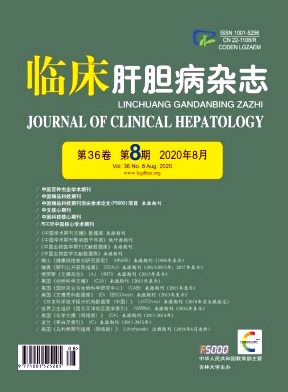|
[1]GARCA-PAGN JC,REVERTER E,ABRALDES JG,et al.Acute variceal bleeding[J].Semin Respir Crit Care Med,2012,33(1):46-54.
|
|
[2]Chinese Society of Hepatology,Chinese Medical Association;Chinese Society of Gastroenteroloty,Chinese Medical Association;Chinese Society of Endoscopy,Chinese Medical Association.Guidelines for the diagnosis and treatment of esophageal and gastric variceal bleeding in cirrhotic portal hypertension[J].J Clin Hepatol,2016,32(2):203-219.(in Chinese)中华医学会肝病学分会,中华医学会消化病学分会,中华医学会内镜学分会.肝硬化门静脉高压食管胃静脉曲张出血的防治指南[J].临床肝胆病杂志,2016,32(2):203-219.
|
|
[3]Portal Hypertension Group,Chinese Society of Surgery,Chinese Medical Association.Expert consensus on the diagnosis and treatment of esophagogastric variceal bleeding in cirrhotic portal hypertension[J].Chin J Pract Surg,2015,35 (10):1086-1090.(in Chinese)中华医学会外科学分会门静脉高压症学组.肝硬化门静脉高压症食管、胃底静脉曲张破裂出血诊治专家共识(2015)[J].中国实用外科杂志,2015,35(10):1086-1090.
|
|
[4]Interventional Group,Chinese Society of Radiology,Chinese Medical Association.Expert consensus on transjugular intrahepatic portosystemic shunt[J].J Clin Hepatol,2017,33 (7):1218-1228.(in Chinese)中华医学会放射学分会介入学组.经颈静脉肝内门体分流术专家共识[J].临床肝胆病杂志,2017,33(7):1218-1228.
|
|
[5]DENG H,QI XS,GUO XZ.UK guidelines on the management of variceal haemorrhage in cirrhotic patients (2015):An excerpt of recommendations[J].J Clin Hepatol,2015,31 (6):852-854.(in Chinese)邓晗,祁兴顺,郭晓钟.《2015年英国肝硬化静脉曲张出血防治指南》摘译[J].临床肝胆病杂志,2015,31(6):852-854.
|
|
[6]CHENG LF,LI CZ.A multi-center survey of esophagogastic variceal bleeding in China[J].J Clin Hepatol,2012,28 (6):462-464.(in Chinese)程留芳,李长政.全国多中心食管胃静脉曲张出血调查[J].临床肝胆病杂志,2012,28(6):462-464.
|
|
[7]Chinese Society of Hepatology,Chinese Medical Association.Chinese guidelines on the management of liver cirrhosis[J].JClin Hepatol,2019,35(11):2408-2425.(in Chinese)中华医学会肝病学分会.肝硬化诊治指南[J].临床肝胆病杂志,2019,35(11):2408-2425.
|
|
[8] Chinese Society of Spleen and Portal Hypertension Surgery,Chinese Society of Surgery,Chinese Medical Association.Expert consensus on diagnosis and treatment of esophagogastric variceal bleeding in cirrhotic portal hypertension (2019edition)[J].Chin J Dig Surg,2019,18 (12):1087-1093.(in Chinese)中华医学会外科学分会脾及门静脉高压外科学组.肝硬化门静脉高压症食管、胃底静脉曲张破裂出血诊治专家共识(2019版)[J].中华消化外科杂志,2019,18(12):1087-1093.
|
|
[9]LEE SW,LEE TY,CHANG CS.Independent factors associated with recurrent bleeding in cirrhotic patients with esophageal variceal hemorrhage[J].Dig Dis Sci,2009,54(5):1128-1134.
|
|
[10]CHEN LG,YE ZS,REN JL,et al.The short-term effect and saftety analysis of endoscopic esophageal variceal ligation[J].Jilin Med J,2014,35(34):7586-7588.(in Chinese)陈立刚,叶震世,任建林,等.内镜食管静脉曲张套扎术的短期疗效和安全性分析[J].吉林医学,2014,35(34):7586-7588.
|
|
[11]CAO YJ,PAN YM,BAO SH,et al.Analysis of prognostic factors of portal hypertension treated with devascularization[J].Chin J Surg,2016,54(6):434-438.(in Chinese)曹亚娟,潘一明,包善华,等.断流术治疗门静脉高压症的预后影响因素分析[J].中华外科杂志,2016,54(6):434-438.
|
|
[12]ZENG DB,DI L,DING J,et al.Clinical efficacy of devascularization in treatment of esophageal and gastric varices in cirrhosis patients with portal hypertension[J/CD].Chin J Hepat Surg:Electronic Edition,2019,8(4):306-310.(in Chinese)曾道炳,邸亮,丁兢,等.断流术治疗肝硬化门静脉高压症食管胃静脉曲张疗效[J/CD].中华肝脏外科手术学电子杂志,2019,8(4):306-310.
|
|
[13]LING WM,LI HF,HUANG QL.Effect of splenectomy combined with pericardial vascular dissection on liver function and hemodynamics in patients with cirrhosis of the portal vein[J/CD].Chin Arch Gen Surg (Electronic Edition),2018,12(2):115-119.(in Chinese)凌伟明,李鸿飞,黄庆录.脾切除联合贲门周围血管离断术对肝硬化门静脉高压症患者肝功能及血流动力学的影响[J/CD].中华普通外科学文献(电子版),2018,12(2):115-119.
|
|
[14]TAN J,ZHOU M,DENG QZ,et al.Transjugular intrahepatic portosystemic shunt (TIPS) for gastroesophageal variceal bleeding in cirrhotic patients with portal hypertension:A 2-year clinical outcomes surveillance study[J].Zhejiang Med J,2019,41(11):1138-1142.(in Chinese)谭俊,周密,邓勤智,等.经颈静脉肝内门体分流术治疗肝硬化门静脉高压症并发食管胃底静脉曲张破裂出血2年生存分析[J].浙江医学,2019,41(11):1138-1142.
|









 本站查看
本站查看




 DownLoad:
DownLoad: